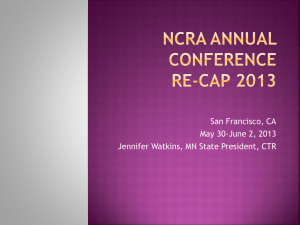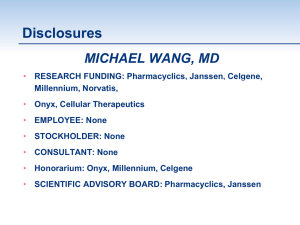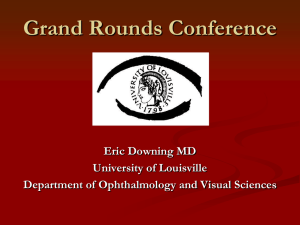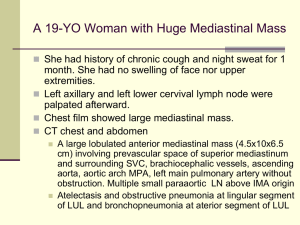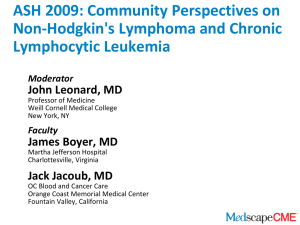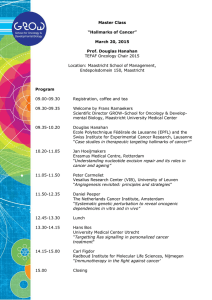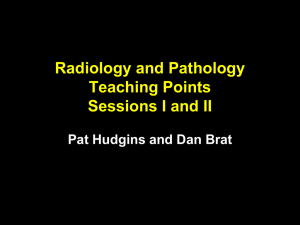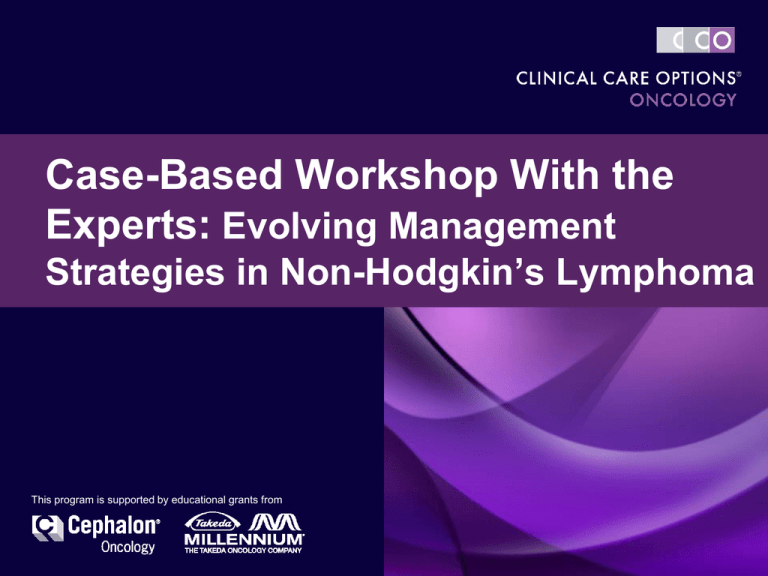
Case-Based Workshop With the
Experts: Evolving Management
Strategies in Non-Hodgkin’s Lymphoma
This program is supported by educational grants from
Multidisciplinary Approaches for
the Diagnosis and Optimal
Treatment of MCL
Owen A. O’Connor, MD, PhD
Professor of Medicine and Pharmacology
Deputy Director for Clinical Research and
Cancer Treatment
NYU Cancer Institute
Chief, Division of Hematologic
Malignancies and Medical Oncology
NYU Langone Medical Center
New York, New York
Evolving Management Strategies in Non-Hodgkin’s Lymphoma
clinicaloptions.com/oncology
About These Slides
Our thanks to the authors who gave permission to include their
original data
Users are encouraged to use these slides in their own
noncommercial presentations, but we ask that content and
attribution not be changed. Users are asked to honor this intent
These slides may not be published or posted online without
permission from Clinical Care Options
Disclaimer
The materials published on the Clinical Care Options Web site reflect the views of the authors of the CCO
material, not those of Clinical Care Options, LLC, the CME providers, or the companies providing
educational grants. The materials may discuss uses and dosages for therapeutic products that have not
been approved by the United States Food and Drug Administration. A qualified healthcare professional
should be consulted before using any therapeutic product discussed. Readers should verify all information
and data before treating patients or using any therapies described in these materials.
Evolving Management Strategies in Non-Hodgkin’s Lymphoma
clinicaloptions.com/oncology
Program Faculty
Program Director
Owen A. O’Connor, MD, PhD
Mary Jo Lechowicz, MD
Professor of Medicine and
Pharmacology
Deputy Director for Clinical Research
and Cancer Treatment
NYU Cancer Institute
Chief, Division of Hematologic
Malignancies and Medical Oncology
NYU Langone Medical Center
New York, New York
Assistant Professor
Hematology/Oncology
Emory University
Atlanta, Georgia
Core Faculty
Christopher R. Flowers, MD, MS
Director, Lymphoma Program
Medical Director, Oncology Data Center
Assistant Professor
Bone Marrow and Stem Cell
Transplantation
Department of Hematology and
Oncology
Emory University
Atlanta, Georgia
Julie M. Vose, MD
Neumann M. and Mildred E. Harris
Professor
Chief, Section of Hematology/
Oncology
Professor of Medicine
University of Nebraska Medical Center
Omaha, Nebraska
Evolving Management Strategies in Non-Hodgkin’s Lymphoma
clinicaloptions.com/oncology
Faculty Disclosures
Christopher R. Flowers, MD, MS, has disclosed that he has received
consulting fees from Celgene and Prescription Solutions and research
funding from Millennium, Pfizer, and Spectrum. He has also disclosed
that he has other (nonpaying advisory boards) relationships with Biogen
Idec and Genentech.
Mary Jo Lechowicz, MD, has no significant financial relationships to
disclose.
Owen A. O’Connor, MD, PhD, has disclosed that he has served as
consultant for Allos, Astellas, Lilly, and Millennium and has received
research support from Allos, Astellas, Lilly, Merck, Millennimum, and
Spectrum.
Julie M. Vose, MD, has disclosed that she has received research funding
from Allos Therapeutics, AstraZeneca, Bristol-Myers Squibb, Celgene,
Exelixis, Genentech, Genzyme, GlaxoSmithKline, Novartis,
Pharmacyclics, and US Biotest.
Evolving Management Strategies in Non-Hodgkin’s Lymphoma
clinicaloptions.com/oncology
Mantle Cell Lymphoma
Median age: 58 yrs
M:F ratio: 3:1
Typically advanced stage
B symptoms: < 50% cases
90% extranodal involvement: BM, blood, liver, GI
Generalized adenopathy: 70% to 90%
CNS involvement at relapse: 4% to 22% (↑ with blastoid)
Fisher RI. Ann Oncol. 1996;7(suppl 6):S35-S39. Armitage JO. Oncology (Williston Park). 1998;12
(10 suppl 8):48-55. Romaguera JE, et al. Cancer. 2003;97:586-591. Gill S, et al. Leuk Lymphoma.
2008;49:2237-2239.
Frontline MCL Therapy
Evolving Management Strategies in Non-Hodgkin’s Lymphoma
clinicaloptions.com/oncology
R-CHOP vs CHOP in Untreated MCL
64 patients randomized in each arm
Response, %
R-CHOP
CHOP
P Value
RR
94
75
.005
CR
34
7
.0002
No differences observed in PFS or OS between treatment
arms
Lenz G, et al. J Clin Oncol. 2005;23:1984-1992.
Evolving Management Strategies in Non-Hodgkin’s Lymphoma
clinicaloptions.com/oncology
STiL: Frontline B-R vs R-CHOP
CD20+ FL, SLL,
MZL, MCL, LPL,
stage III-IV,
untreated, 18 yrs
of age or older
(N = 549)
Bendamustine-Rituximab (n = 260)
B 90 mg/m2 on Days 1, 2 +
R 375 mg/m2 on Day 1
Max 6 cycles q4w
R-CHOP (n = 253)
Max 6 cycles q3w
Primary endpoint: PFS (noninferiority B-R < 10% at 3 yrs)
Secondary endpoints: ORR, CR, toxicity, stem cell mobilization
Rummel MJ, et al. ASH 2009. Abstract 405.
Evolving Management Strategies in Non-Hodgkin’s Lymphoma
clinicaloptions.com/oncology
STiL: BR vs R-CHOP, All Disease Types
513 evaluable patients > 1/2 FL/18% MCL
No difference in ORR between treatment arms
CR
PFS
– B-R: 40%
– B-R: 55 mos
– R-CHOP: 31%
– R-CHOP: 35 mos
– P = .03
– P < .05
BR toxicity profile: alopecia, neutropenia,
thrombocytopenia, infections
Rummel MJ, et al. ASH 2009. Abstract 405.
Dose-Intensive Approaches
Evolving Management Strategies in Non-Hodgkin’s Lymphoma
clinicaloptions.com/oncology
MCL: High-Dose Therapy/ASCT—CHOP
Backbone
1.0
ASCT
IFN
P = .0108
0.8
0.8
P (EPS)
Survival Probability
1.0
0.6
0.4
0.2
0.6
0.4
0.2
0
0
1
2
3
4
5
Yrs After End of Induction Therapy
Pts at Risk, n
ASCT 62
38
IFN
60
33
Response, Yrs
31
19
17
9
10
6
6
3
2
IFN Arm
ASCT arm
P Value
Median DOR
1.6
3.7
.0004
Median TTF (ITT)
1.4
2.6
.0001
OS
5.4
7.5
.075
0
0
10
20
30
Mos
40
50
60
Tripled CR rate after DHAP
(12% vs 61%)[2]
Median EFS: 84 mos vs 51 mos
prior to rituximab[1]
1. Lefrere F, et al. Leukemia. 2002;16:587-593. 2. Delarue R, et al. ASH 2008. Abstract 581.
3. Dreyling M, et al. ASH 2008. Abstract 769. Dreyling M, et al. Blood. 2005;105:2677-2684.
Evolving Management Strategies in Non-Hodgkin’s Lymphoma
clinicaloptions.com/oncology
MCL: High-Dose Therapy/ASCT—More
Intensive Induction
B
EFS
R-HDS low risk
R-HDS int-high risk
80
60
40
20
0
EFS
100
Percent Survival
100
Percent Survival
A
P < .0001
MCL2 (n = 160)
MCL1 (n = 41)
80
60
40
20
P < .0001
0
0 12 24 36 48 60 72 84 96 108 120
Mos
0
2
4
6
8
10
Yrs
Small series
EFS, PFS, OS, and mol CR/previous
CHOP—ASCT
Long follow-up
Bias? (toxic regimen)
Preemptive rituximab maintenance
based on QPCR
MCL3/similar + ibritumomab tiuxetan
prior ASCT[3]
Magni M, et al. Bone Marrow Transplant. 2009;43:509-511. 2. Geisler et al. Blood. 2008;112:269-293.
3. Kolstadt, et al. ASH 2009. Abstract 932.
Evolving Management Strategies in Non-Hodgkin’s Lymphoma
clinicaloptions.com/oncology
EU Trial: MCL Younger Protocol Design
Patients younger
than 65 yrs of age
with MCL, ECOG
PS < 2,
Ann Arbor
stage II-IV,
eligible for highdose therapy
(2 + 1) x
R-CHOP/DHAP
alternating
(stem cell mobilization
after course 6)
4 x R-CHOP
2 x R-CHOP
TBI 10 Gy
Ara-C 4 x 1.5 g/m2 +
Melphalan 140 mg/m2 +
PBSCT
DexaBEAM
(stem cell mobilization)
Primary endpoint: time to treatment failure
Secondary endpoints: response rates, OS, toxicity
Hermine O, et al. ASH 2010. Abstract 110.
Cyclo
120 mg/kg +
TBI 12 Gy
PBSCT
Evolving Management Strategies in Non-Hodgkin’s Lymphoma
clinicaloptions.com/oncology
EU Trial: Results
Time to Treatment Failure PP
MCL Younger:
Remission Duration After ASCT
Median follow-up: 32 mos
R-DHAP, median not reached
R-CHOP, median: 49 mos
1.0
Median follow-up: 30 mos
R-DHAP, median not reached
R-CHOP, median: 48 mos
1.0
HR: 0.68
0.8
Probability
Probability
0.8
0.6
0.4
0.2
0.6
0.4
0.2
P = .0382 (1-sided sequential test)
P = .0059
0
0
0
12
24
36
48
60
Mos Since Randomization
Pts at Risk, n
R-DHAP 208 147
99
67
29
11
R-CHOP 212 134
95
66
36
11
Hermine O, et al. ASH 2010. Abstract 110.
72
0
0
0
Pts at Risk, n
R-DHAP 133
R-CHOP 133
12
24
36
48
60
Mos Since Retransfusion
99
92
69
66
45
43
19
15
0
1
72
0
Evolving Management Strategies in Non-Hodgkin’s Lymphoma
clinicaloptions.com/oncology
High-Dose Therapy/ASCT: Summary
No difference in ORR (97%) or CR/CRu (79/82%) postASCT
Measure, n (%)
R-CHOP
R-CHOP/
R-DHAP
P Value
CR
54 (26)
72 (36)
.032
CR or CRu
83 (40)
111 (55)
.0028
CR or CRu or PR
186 (90)
188 (94)
.14
Relapse after CR/CRu/PR
49 (23)
22 (10)
--
Hermine O, et al. ASH 2010. Abstract 110.
Evolving Management Strategies in Non-Hodgkin’s Lymphoma
clinicaloptions.com/oncology
Comparison of Dose-Intensive/High-Dose
Therapy in MCL
Ara-C–containing induction regimens for MCL
Study
Therapy
N
Age Limit,
Yrs
5-Yr EFS,
%
5-Yr OS,
%
Follow-up,
Mos
Nordic[1]
MCL-2
(R + Maxi-CHOP +
HD Ara-C + Maint R)
160
< 66
63
74
40
GITIL[2]
(R) HDS-ASCT*
77
< 61
61
74
50
R-HyperCVAD
97
Up to 80
(1/3 > 65)
48 (FFS)
65
50
≤ 65
60 (FFS)
76
50
MDACC[3,4]
CALGB
R-Maxi-CHOP-MTX/
VP16-Ara-C/CBV
78
18-69
56 (PFS
64
50
EU younger
patients
R-CHP/DHAP-TAM
→ ASCT
208
< 65
65 (TTF)
78
32
*4 MDS and 3 solid tumors.
Compare to R-CHOP PFS 25% at 52 yrs
1. Geisler CH, et al. ASH 2007. Abstract LBA1. 2. Cortelazzo S, et al. ASH 2007. Abstract 1282. 3. Romaguera JE, et al.
J Clin Oncol. 2005;23:7013-7023. 4. Fayad L, et al. Clin Lymphoma Myeloma. 2007;8(suppl 2):S57-S62.
Evolving Management Strategies in Non-Hodgkin’s Lymphoma
clinicaloptions.com/oncology
SWOG 0213: R-HyperCVAD in MCL
Outcome
100
Median age, yrs
57
80
Mantle zone
variant, %
57
Grade 3/4
infection, %
34
Discontinued
Rx/toxicity, %*
42
Patients (%)
Measure
OS
PFS
60
40
20
0
0
1
Efficacy, n (%)
ORR
35 (88)
Survival, %
CR/CRu
23 (58)
PR
12 (30)
*No details on dose reductions
Epner EM, et al. ASH 2007. Abstract 387.
2
3
4
5
Yrs From Registration
1 Yr
2 Yrs
PFS
89
64
OS
91
76
6
Evolving Management Strategies in Non-Hodgkin’s Lymphoma
clinicaloptions.com/oncology
Modified R-HyperCVAD: Design
A
S
S
E
S
S
Rituximab 375 mg/m2 on Day 1 +
Cyclophosphamide 300 mg/m2 q12 hrs on Days 1-3 +
Doxorubicin 50 mg/m2 48-hr CI on Days 1-2 +
Vincristine 2 mg IV on Day 3 +
Dexamethasone 40 mg PO on Day 1-4
Rituximab
375 mg/m2
once wkly × 4
q6m × 4
CR,
CRu,
PR
No vincristine or steroids on Day 11/no methotrexate, no Ara-C/monthly cycles x 6
Median follow-up: 37 mos
22 untreated MCL
Toxicity mainly hematologic
Patients
ORR (n = 22)
77
CR/CRu
64
PR
14
Patients Alive (%)
Clinical Response, %
100
OS
80
60
PFS
40
Median PFS: 37 mos
20
0
0
Kahl BS, et al. Ann Oncol. 2006;17:1418-1423.
Median OS:
not reached
10
20
30
Mos
40
50
60
Evolving Management Strategies in Non-Hodgkin’s Lymphoma
clinicaloptions.com/oncology
NCCN Study in MCL: PFS
PFS K-M
2-Group Log Rank
P Value
R-hyperCVAD vs R-CHOP
< .001
R-CHOP+HDT/ASCR vs R-CHOP
< .001
R-hyperCVAD vs R-CHOP + HDT/ASCR
LaCasce A, et al. ASH 2009. Abstract 403.
.58
Evolving Management Strategies in Non-Hodgkin’s Lymphoma
clinicaloptions.com/oncology
NCCN Study in MCL: OS
OS K-M
2-Group Log Rank
P Value
R-hyperCVAD vs R-CHOP
.02
R-CHOP+HDT/ASCR vs R-CHOP
.20
R-hyperCVAD vs R-CHOP + HDT/ASCR
.64
LaCasce A, et al. ASH 2009. Abstract 403.
Evolving Management Strategies in Non-Hodgkin’s Lymphoma
clinicaloptions.com/oncology
FCM vs R-FCM in Relapsed Indolent
Lymphoma
4 cycles FCM vs R-FCM
Relapsed indolent lymphoma
R
Fludarabine
Cyclophosphamide
Mitoxantrone
+ Rituximab
Fludarabine
Cyclophosphamide
Mitoxantrone
128 patients evaluable with relapsed indolent NHL;
48 evaluable patients with MCL
Outcome in MCL Patients
FCM
(n = 24)
FCM-R
(n = 24)
P Value
ORR, %
46
58
.282
CR, %
0
29
NR
Median PFS, mos
4
8
.3887
Median OS, mos
11
Not reached
.0042
Forstpointner R, et al. Blood. 2004;104:3064-3071.
Evolving Management Strategies in Non-Hodgkin’s Lymphoma
clinicaloptions.com/oncology
Frontline Radioimmunotherapy in MCL
Study
MSKCC 01029[1]
ECOG 1499[2]
Design
Tositumomab
CHOP x 6
No rituximab
Results/Comments
Feasible
35% eval pts had mol CR post-RIT
Not improved post-CHOP
R-CHOP x 4
56 pts/med age: 61 yrs
Ibritumomab tiuxetan Tripled CR rate: 45%
(14% after R-CHOP)
Med FFS at 27 mos
(> R-CHOP alone)
1. Zelenetz A, et al. ASCO 2006. Abstract 7560. 2. Smith M, et al. ASH 2007. Abstract 389.
Evolving Management Strategies in Non-Hodgkin’s Lymphoma
clinicaloptions.com/oncology
Radioimmunotherapy in MCL
Study Design
Results/Comments
I131Tositumomab + HDT cyclophosphamide
+ etoposide + ASCT
FHCRC[1]
34 pts heavily pretreated
Med number of previous Rx: 3 (106)
50% refractory to last Rx
5-yr PFS: 42%
High-dose Ibritumomab
Tiuxetan + ASCT in DLCL and MCL
City of Hope[2]
42 pts, 1/3 MCL
Med number of previous Rx: 2 (1-6)
1. Gopal AK, et al. Blood. 2002;99:3158-3162.
2. Krishnan A, et al. J Clin Oncol. 2008;26:90-95.
Relapsed/Refractory MCL
Evolving Management Strategies in Non-Hodgkin’s Lymphoma
clinicaloptions.com/oncology
Relapsed/Refractory MCL
Agent
Cladribine
Regimen
Outcomes
Single agent[1]
25 pts with recurrent disease
ORR: 46%; CR: 21%
Median PFS: 5.4 mos
Single agent[2]
Bendamustine + rituximab[3]
16 MCL patients
ORR: 75%; CR: 50%
Median PFS: 18 mos
Bendamustine + rituximab[4]
12 MCL patients
ORR: 92%; CR/CRu: 59%
Median DOR: 19 mos
Bendamustine
1. Inwards DJ, et al. Cancer. 2008;113:108-116. 2. Ogura M, et al. ASH 2009. Abstract 3694. 3. Rummel
MJ, et al. J Clin Oncol. 2005;23:3383-3389. 4. Robinson KS, et al. J Clin Oncol. 2008;26:4473-4479.
Evolving Management Strategies in Non-Hodgkin’s Lymphoma
clinicaloptions.com/oncology
Single-Agent Y-90 Ibritumomab Tiuxetan
for Relapsed/Refractory MCL
N = 34
Median age: 68 yrs; median previous regimens: 3
Dosed by platelet count
– ≥ 150,000 cells/mm3: 0.4 mCi/kg
– < 150,000 to ≥ 150,000 cells/mm3: 0.3 mCi/kg
ORR: 31%
Median EFS: 6 mos (28 mos for patients with response)
Median OS: 21 mos
Grade 3/4 thrombocytopenia: 24%; grade 3/4 neutropenia:
32%
Wang M, et al. J Clin Oncol. 2009;27:5213-5238.
Evolving Management Strategies in Non-Hodgkin’s Lymphoma
clinicaloptions.com/oncology
1.3 mg/m2
1.5 mg/m2
Bortezomib: Summary of Efficacy
in Mantle Cell Lymphoma
Study
N
CR, n (%)
PR, n (%)
ORR, % (n)
O’Connor[1]
40
5 (13)
14 (35)
47
Goy[2]
29
6 (21)
6 (21)
41
Strauss[3]
24
1 (4)
6 (24)
29
Belch, n[4]
13 untreated/
15 relapsed
0
1
6
6
46
47
PINNACLE[5]
141
11 (8)
36 (26)
47 (33)
Total
262
24 (9)
74 (28)
98 (37)
Similar ORR across studies and for untreated/relapsed
1. O’Connor OA, et al. Br J Haematol. 2009;145:34-39. 2. Goy A, et al. J Clin Oncol. 2005;23:667-675.
3. Strauss SJ, et al. J Clin Oncol. 2006;13:2105-2112. 4. Belch A, et al. Ann Oncol. 2007;18:116-121.
5. Fisher RI, et al. J Clin Oncol. 2006;24:4867-4874.
Evolving Management Strategies in Non-Hodgkin’s Lymphoma
clinicaloptions.com/oncology
PINNACLE Trial Update
Response/Subsets Analysis
Parameter
Response:
Evaluable
(n = 141)
Refractory MCL*
(n = 51)
Previous
High-Intensity Therapy†
(n = 52)
ORR, %
32
29
25
CR/CRu, %
8
6
10
9.2
5.9
Not reached
Median DOR, mos
*Refractory subgroup: no response or response with TTP < 6 mos to last previous line of therapy.
†High-intensity subgroup: ASCT or therapies containing high-dose cytarabine or ifosfamide/carboplatin
etoposide.
Among patients who achieved CR/CRu: median DOR not reached at
26.4 mos
Goy A, et al. Ann Oncol. 2009;20:520-525.
Evolving Management Strategies in Non-Hodgkin’s Lymphoma
clinicaloptions.com/oncology
Early Data of Combination Bortezomib
With Common MCL Regimens
Combination
Design
Results
Comment
R-CHOP
GELA[1]
2 arms
Wkly vs biwkly
Dose escalation in each arm
MCL, FL, MZL, DLCL IPI 0
48 pts
4 MCL
ORR 100% biwkly
Need longer follow-up
Grade 3 neurotoxicity > 20%
9/10 in biwkly + highest dose
R-CHOP
Cornell[2]
R-CHOP + bortz
Days 1 and 4 only ++
DLCL and MCL
36 MCL
Well tolerated
Modified
R-hyperCVAD[3]
Modified R-hyperCVAD
+ bortz Days 1, 4
30 pts
ORR: 90%
CR: 77%
Neuropathy excessive at
1.5 dose; capped VCR at 1.0
and bortz at 1.3
Modified
R-hyperCVAD[4]
Modified R-hyperCVAD
+ bortz 1.3 mg/m2 Days 1, 4
Classic
R-hyperCVAD[5]
Full R-hyperCVAD
Bortezomib Days 1, 4 cycle
A and Days 2, 5 cycle B
16 pts phase I
No unexpected toxicity so far
Including PFTs
Bendamustine +
Rituximab[6]
1. Mounier N, et al. ASCO 2007. Abstract 8010. 2. Ruan J, et al. ASH 2009. Abstract 2682. 3. Kahl B, et al. ASH 2008.
Abstract 265. 4. Kahl BS, et al. ASH 2009. Abstract 1661. 5. Romaguera J. ICML 2008. Abstract 444. 6. Friedberg JW, et al.
ASH 2009. Abstract 924.
Evolving Management Strategies in Non-Hodgkin’s Lymphoma
clinicaloptions.com/oncology
Lenalidomide: IMiDs
Lenalidomide
mechanism of action
remains poorly
understood
Antiangiogenic,
microenvironment,
direct antiproliferative,
NK, and T-regs
List AF. N Engl J Med. 2007;357:2183-2186. Copyright © 2007 Massachusetts Medical Society.
All rights reserved.
Evolving Management Strategies in Non-Hodgkin’s Lymphoma
clinicaloptions.com/oncology
Lenalidomide in MCL: Phase II NHL-003
Trial
N = 203; MCL pts, n = 53
Median number of previous Rx: 3 (1-8)
DOR: NR (13.7 mos in previous NHL-002 trial)
Results
%
Response
ORR
41
14 patients previous bortezomib
57
CR/CRu
13
PR
28
SD
26
PD
33
Toxicity (myelotoxicity)*
Dose reductions
38
Zinzani PL, et al. ASH 2008. Abstract 262. Reeder CB, et al. ASH 2008. Abstract 1560. Czuczman MS, et
al. ASH 2008. Abstract 268. Habermann TM, et al. Br J Haematol. 2009;145:344-349.
Evolving Management Strategies in Non-Hodgkin’s Lymphoma
clinicaloptions.com/oncology
CALGB 50501: Bortezomib + Lenalidomide
in Rel/Ref MCL—Planned Interim Analysis
Eligibility
– Histologically documented MCL (CD5+, CD23-, cyclin D1+)
– Measurable disease
– PD 0-2
– Previous treatment with ≥ 1 regimen (including autologous
SCT)
– No previous radioimmunotherapy
– No ≥ 3 grade 3 PN
Morrison VA, et al. ASCO 2010. Abstract 8106.
Evolving Management Strategies in Non-Hodgkin’s Lymphoma
clinicaloptions.com/oncology
CALGB 50501: Bortezomib + Lenalidomide
in Rel/Ref MCL—Planned Interim Analysis
Induction therapy given every 21 days for 8 cycles
– Lenalidomide 20 mg PO QD on Days 1-14
– Bortezomib 1.3 mg/m2 on Days 1, 4, 8, 11
Responding patients at 6 mos continued to maintenance
therapy
Primary endpoint: ORR
Secondary endpoints: TTP, DFS/OS, correlating changes
in activate NK/T cells and plasma cytokines with response
Morrison VA, et al. ASCO 2010. Abstract 8106.
Evolving Management Strategies in Non-Hodgkin’s Lymphoma
clinicaloptions.com/oncology
CALGB 50501: Bortezomib + Lenalidomide
in Rel/Ref MCL—Planned Interim Analysis
Target accrual: 54 patients
Planned interim analysis performed at 19 patients
Grade 3/4 toxicity data for 31 patients
– Anemia: 3/0
– Infection: 6/0
– Leukopenia: 3/0
– Motor neuropathy: 13/0
– Thrombocytopenia: 19/13
– Sensory neuropathy: 3/0
– Fatigue/asthenia: 19/0
– Hypotension: 13/0
– Dyspnea: 16/0
Morrison VA, et al. ASCO 2010. Abstract 8106.
Evolving Management Strategies in Non-Hodgkin’s Lymphoma
clinicaloptions.com/oncology
Targeting the PI3K/mTOR Pathway
Key pathway for multiple receptor tyrosine kinases/cell
proliferation and protein translation
Activated Ras
PI3K
PIP2
PIP3
PTEN
ILK
PDK1
Akt
pAkt
ppAkt
pTSC2
+
TSCI
TSC1-TSC2
Rheb.GTP
eIF4E.4EBP-1 complex
Rheb.GTP
Rapamycin
+
FKBP12
p70S6k
Rapamycin + FKBP12
P 4E-BP1
+
eIF4E
Cyclin D1 mRNA
P p70S6k
Protein S6
P S6
Cyclin D1 protein
Evolving Management Strategies in Non-Hodgkin’s Lymphoma
clinicaloptions.com/oncology
Temsirolimus (CCI-779) in MCL
Multicenter, open-label, phase III trial
Relapsed/refractory MCL
Temsirolimus 175 mg QW x 3
then 75 mg QW
Required
rituximab
anthracycline
alkylating agent
Temsirolimus 175 mg QW x 3
then 25 mg QW
(N = 162)
Hess G, et al. J Clin Oncol. 2009;27:3822-3829.
Investigators’ choice
single agent
Evolving Management Strategies in Non-Hodgkin’s Lymphoma
clinicaloptions.com/oncology
Temsirolimus (CCI-779) in MCL
Temsirolimus
175/75
(n = 54)
Temsirolimus
175/25
(n = 54)
Investigators’
Choice
(n = 54)
ORR, %
22*
6
2
Median DOR, mos
7.1
3.6
NA
Median PFS, mos
4.8†
3.4
1.9
Median OS, mos
11.1
8.8
9.5
Response
*P vs investigator choice = .0019; †P vs investigators’ choice = .0009
Hess G, et al. J Clin Oncol. 2009;27:3822-3829.
Evolving Management Strategies in Non-Hodgkin’s Lymphoma
clinicaloptions.com/oncology
Targeting Cyclin/CDK complexes
Flavopiridol
Semisynthetic flavone analogue of rohitukine (Indian tree) that blocks several
CDKs, including complex CDK4-cyclin D1
Initial schedules: ORR 11% (only PR)/strong binding to human proteins
– LC50 required 5 x higher with human serum
Pharmacologically modified schedules very promising
– 30-min bolus followed by 4-hr infusion
CLL
– ORR 45%, med DOR > 12 mos, even in p53-deleted pts
– 55% grade 3/4 lysis syndromes +++, thrombocytopenia
Other CDK inhibitors coming: PD0332991 ++
Kouroukis CT, et al. J Clin Oncol. 2003;21:1740-1745. Lin TS, et al. Leuk Lymphoma. 2002;43:793-797.
Byrd JC, et al. Blood. 2007;109:399-404.
Evolving Management Strategies in Non-Hodgkin’s Lymphoma
clinicaloptions.com/oncology
Gemcitabine in MCL
Single-agent gemcitabine (N = 18; 9 newly diagnosed, 9 relapsed)[1]
– Response rate: 5/18 (28%)
– CR: n = 1; PR: n = 4
– Median treatment response duration: 10.6 mos
Gemcitabine/mitoxantrone/rituximab for relapsed/refractory (N = 16)[2]
– Best responses
– CR: 20%; PR: 27%
– Grade 3/4 toxicities: neutropenia (100%), thrombocytopenia (67%),
leukopenia (53%), anemia (33%)
– Median PFS and OS not reached at 10.7 mos
1. Hitz F, et al. Hematol Oncol. 2009;27:154-159. 2. Garbo LE, et al. Invest New Drugs. 2009;27:476-481.
Evolving Management Strategies in Non-Hodgkin’s Lymphoma
clinicaloptions.com/oncology
MIPI and Survival in Patients Receiving
RHCVAD and R-MTX-Ara-C
Single-agent, retrospective cohort study
Study designed to identify predictors of survival on
patients on first-line RHCVAD therapy
Primary endpoints: OS and PFS assessed by chart review
Analysis included 53 patients with advanced MCL
receiving RHCVAD alternating with R-MTX-Ara-C every
21 days (median: 6 cycles)
Mato AR, et al. ASCO 2010. Abstract 8092.
Evolving Management Strategies in Non-Hodgkin’s Lymphoma
clinicaloptions.com/oncology
MIPI and Survival in Patients Receiving
RHCVAD and R-MTX-AraC: Results
Median OS and PFS not yet reached (median follow-up:
18 mos [range: 35-74])
MIPI classified 47%, 29%, and 24% of patients as low,
intermediate, and high risk
– MIPI did not identify 3 distinct categories by K-M analysis for OS
or PFS
Univariate analysis showed blastoid variant only significant
predictor for OS (HR: 9.4; 95% CI: 1.2-53.1)
Age, ECOG PS, WBC, LDH, β2-microglobulin not predictive of
OS
Blastoid variant (HR: 8.8; P .05) and β2-microglobulin (HR: 1.9;
P .01) were independent predictors for PFS
Mato AR, et al. ASCO 2010. Abstract 8092.
Evolving Management Strategies in Non-Hodgkin’s Lymphoma
clinicaloptions.com/oncology
Risk-Adapted Transplantation in MCL
Retrospective study of mature results of 17 yrs of
transplantation experience in 121 MCL patients at M. D.
Anderson Cancer Center
– AUTO1 (n = 50): patients who received autologous SCT
during first CR or PR
– AUTO2 (n = 36): patients who received autologous SCT for
relapsed/refractory disease
– NST (n = 35): patients who received nonmyeloablative SCT
for relapsed/refractory disease
Tam CS, et al. Blood. 2009;113:4144-4152.
Evolving Management Strategies in Non-Hodgkin’s Lymphoma
clinicaloptions.com/oncology
1.0
AUTO1 (n = 50)
AUTO2 (n = 36)
NST
(n = 35)
P = .01
P = .01
0.8
1.0
Proportion Alive
Proportion Alive Without
Progression
MCL: ASCT/Allogeneic Transplantation
0.6
0.4
0.2
0
0.8
AUTO1 (n = 50)
P = .02
AUTO2 (n = 36)
P = .10*
NST
(n = 35)
*P = .006 at 4 yrs landmark
0.6
0.4
0.2
0
0 12 24 36 48 60 72 84 96 108120 132 144
PFS (Mos)
0 12 24 36 48 60 72 84 96 108120 132 144
OS (Mos)
Single institution/not very large numbers
ASCT in first CR > ASCT in relapse (but no plateau either way)
Mini-allo ~ 50% at 5 yrs: prediction is PBSCT and chimerism ≥ 95%
Tam CS, et al. Blood. 2009;113:4144-4152. This research was originally published in Blood. © American
Society of Hematology.
Evolving Management Strategies in Non-Hodgkin’s Lymphoma
clinicaloptions.com/oncology
Other Novel Agents in MCL
Drug
Mechanisms/Study
Other antiangiogenesis agents
Thalidomide/rituximab/bevacizumab/VEGF Trap
Anti-TRAIL antibodies
(TRM-1)
Fully human Mab agonistic to the TRAIL receptor 1
Induction apoptosis/extrinsic pathway
HSP inhibitors
17AAG (geldamycin)
Rationale to overcome bortezomib resistance
IKK inhibitors
Inhibitors of Raf/MEK signaling
pathway
HDAC inhibitors (SAHA,
depsipeptide)
Farnesyl transferase inhibitors
BL22 immunotoxin
Others
Stabilization of NF-κB
Sorafenib, orally administered
Small-molecule signal transduction inhibitor
SAHA showed activity in MCL in preclinical models
Tipifarnib/ongoing
Calicheamicin/CD22 (CMC-544)
Bcl-2 inhibitors
Go Online for More CCO
Hematology/Oncology Activities!
Conference coverage of key data hematology/oncology meetings
Treatment updates in various tumor types and hematologic
malignancies
Downloadable slide sets for use as a
self-study resource or in your own
non-commercial presentations
clinicaloptions.com/oncology

